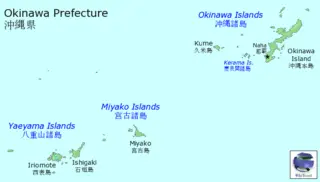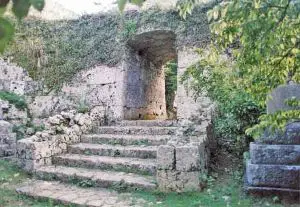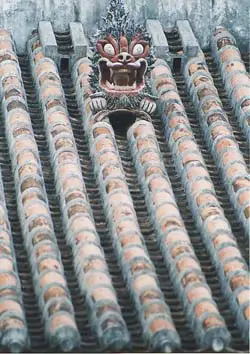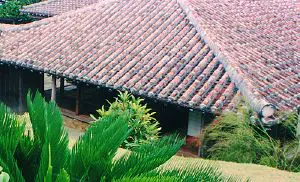Okinawa
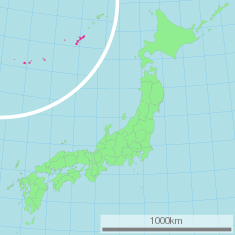
| |
| Capital | Naha |
| Region | Ryūkyū Archipelago |
| Island | Okinawa |
| Governor | Hirokazu Nakaima |
| Area | 2,271.30 km² (44th) |
| - % water | 0.5% |
| Population (October 1, 2000) | |
| - Population | 1,318,218 (32nd) |
| - Density | 580 /km² |
| Districts | 5 |
| Municipalities | 41 |
| ISO 3166-2 | JP-47 |
| Website | www.pref.okinawa.jp/ english/ |
| Prefectural Symbols | |
| - Flower | Deigo (Erythrina variegata) |
| - Tree | Pinus luchuensis (ryūkyūmatsu) |
| - Bird | Okinawa woodpecker (Sapheopipo noguchii) |
 Symbol of Okinawa Prefecture | |
- "Okinawa" redirects here.
Okinawa Prefecture (沖縄県 Okinawa-ken, Okinawan: Uchinā) is one of Japan's southern prefectures, and consists of hundreds of the Ryukyu Islands in a chain over 1,000 km long, which extends southwest from Kyūshū (the southwesternmost of Japan's main four islands) to Taiwan. Okinawa's capital, Naha, is located in the southern part of the largest and most populous island, Okinawa Island, which is approximately half-way between Kyūshū and Taiwan. The disputed Senkaku Islands (Chinese: Diaoyu Islands) are also administered as part of Okinawa Prefecture at present.
History
The oldest evidence of human existence in the Ryukyu islands was discovered in Naha City and Yaese Town[1]. Some human bone fragments from the Paleolithic era were unearthed, but there is no clear evidence of Paleolith remains. Japanese Jōmon influences are dominant in the Okinawa Islands, although clay vessels in the Sakishima Islands have a commonality with those in Taiwan.
The first mention of the word Ryukyu was written in the Book of Sui. This Ryukyu might refer to Taiwan, not the Ryukyu islands. Okinawa was the Japanese word depicting the islands, first seen in the biography of Jianzhen, written in 779. Agricultural societies begun in the 8th century slowly developed until the 12th century. Since the islands are located in the center of the East China Sea relatively close to Japan, China and South-East Asia, the Ryūkyū Kingdom became a prosperous trading nation. Also during this period, many Gusukus, similar to castles, were constructed. The Ryūkyū Kingdom had a tributary relationship with the Chinese Empire beginning in the 15th century.
In 1609 the Satsuma clan, which controlled the region that is now Kagoshima Prefecture invaded the Ryūkyū Kingdom. Following the invasion the Ryūkyū Kingdom surrendered to the Satsuma and was forced to form a tributary relationship with Satsuma and the Tokugawa shogunate, in addition to its previous relationship with China. Ryukyuan sovereignty was maintained since complete annexation would create a problem with China. The Satsuma clan earned considerable profits from trades with China during a period in which foreign trade was heavily restricted by the shogunate.
Though Satsuma maintained strong influence over the islands, the Ryūkyū Kingdom maintained considerable degree of domestic political freedom for over two hundred years. Four years after the 1868 Meiji Restoration, the Japanese government, through military incursions, officially annexed the kingdom and renamed it Ryukyu han. At the time, the Qing Dynasty of China asserted sovereignty over the islands of the Ryūkyū Kingdom, since the Ryūkyū Kingdom was a tributary nation of China. The Okinawa han became a prefecture of Japan in 1879, while all other hans had became prefectures of Japan in 1872.
Following the Battle of Okinawa and the end of World War II in 1945, Okinawa was under the United States administration for 27 years. During the trusteeship rule the USAF established numerous military bases on the Ryukyu islands.
In 1972, the U.S. government returned the islands to Japanese administration. Under the Treaty of Mutual Cooperation and Security, the United States Forces Japan (USFJ) have maintained a large military presence. 27000 personnel, including 15000 Marines, contingents from the Navy, Army and Air Force, and their 22,000 family members are stationed in Okinawa.[2] 18% of the main island was occupied by US military bases and 75% of all USFJ bases are located in Okinawa prefecture.[3]
85% of the Okinawans oppose the large presence of the USFJ and demand the consolidation, reduction and removal of US military bases from Okinawa.[4] Repeated accidents and crimes committed by U.S. servicemen have reduced local citizens' support for the U.S. military bases. The Japanese and the US government consider the mutual security treaty and the USFJ absolutely necessary and neglected the awkward situation in Okinawa for decades. The rape of a 12 year old girl by U.S. servicemen in 1995 triggered large protests in Okinawa. As a result, both the U.S. and Japanese governments agreed to the relocation of the Marine Corps Air Station Futenma and other minor bases. However, at present, the closure of the bases has been indefinitely postponed. These disagreements also contribute to the relatively recent anti-Japanese sentiment and subsequently Ryukyu independence movement.
Geography
Major islands
The set of islands belonging to the prefecture is called Ryūkyū Shotō (琉球諸島). Okinawa's inhabited islands are typically divided into three geographical archipelagos. From northeast to southwest:
- Okinawa Islands
- Ie-jima
- Kume
- Okinawa Honto
- Tokashiki
- Miyako Islands
- Miyako-jima
- Yaeyama Islands
- Iriomote
- Ishigaki
- Yonaguni
Cities
Okinawa Prefecture includes eleven cities.
- Ginowan
- Ishigaki
- Itoman
- Miyakojima
- Nago
- Naha (capital)
- Nanjo
- Okinawa City (formerly Koza)
- Tomigusuku
- Urasoe
- Uruma
Towns and villages
These are the towns and villages in each district.
|
|
Mergers
Demography
Okinawa prefecture age pyramid as of 1 October 2003
(per 1000's of people)
| Age | People |
|---|---|
| 0-4 | |
| 5-9 | |
| 10-14 | |
| 15-19 | |
| 20-24 | |
| 25-29 | |
| 30-34 | |
| 35-39 | |
| 40-44 | |
| 45-49 | |
| 50-54 | |
| 55-59 | |
| 60-64 | |
| 65-69 | |
| 70-74 | |
| 75-79 | |
| 80 + |
Okinawa Prefecture age pyramid, divided by sex, as of 1 October 2003
(per 1000's of people)
Climate and nature
The island is largely composed of coral rock, and rainwater filtering through that coral has given the island many caves, which played an important role in the Battle of Okinawa. Gyokusendo, an extensive limestone cave in the southern part of Okinawa's main island, is a popular tourist attraction.
Okinawa is said to have the most beautiful beaches in all of Japan and normally enjoys temperatures above 20 degrees Celsius for most of the year. Okinawa and the many islands that make up the prefecture boast some of the most abundant coral reefs found in the world. Rare blue corals are found off of Ishigaki and Miyako islands as are numerous species throughout the chain. Many coral reefs are found in this region of Japan and wildlife is abundant. Sea turtles return yearly to the southern islands of Okinawa to lay their eggs. The summer months carry warnings to swimmers regarding poisonous jellyfish and other dangerous sea creatures. Okinawa is a major producer of sugar cane, pineapple, papaya, and other tropical fruit, and the Southeast Botanical Gardens represent tropical plant species.
Language and culture
Having historically been a separate nation, Okinawan language and culture differ considerably from that of mainland Japan.
Language
There remain numerous Ryukyuan languages which are more-or-less incomprehensible to Japanese speakers. These languages are in decline as the Mainland Japanese is being used by the younger generation. Many linguists, at least those outside Japan, consider Ryukyuan languages as different languages from Japanese, while they are generally perceived as "dialects" by mainland Japanese and Okinawans themselves. Standard Japanese is almost always used in formal situations. In informal situations, de facto everyday language among Okinawans under age 60 is Okinawa-accented mainland Japanese called ウチナーヤマトグチ (Uchinā Yamatoguchi "Okinawan Japanese"), which is often misunderstood as Okinawan language proper, ウチナーグチ (Uchināguchi "Okinawan language"). Uchināguchi still is used in traditional cultural activities, such as folk music, or folk dance. There is a radio news program in the language as well. [1]
Religion
Okinawa also has its own religious beliefs, generally characterized by ancestor worship and the respecting of relationships between the living, the dead, and the gods and spirits of the natural world.
Cultural influences
Okinawan culture bears traces of its various trading partners. One can find Chinese, Thai and Austronesian influences in the island's customs. Perhaps Okinawa's most famous cultural export is karate, probably a product of the close ties with and influence of China on Okinawan culture. Karate is thought to be a synthesis of Chinese kung fu with traditional Okinawan martial arts. A ban on weapons in Okinawa for two long periods after the invasion and forced annexation by Japan during the Meiji Restoration period also very likely contributed to its development.
Another traditional Okinawan product that owes its existence to Okinawa's trading history is awamori—an Okinawan distilled spirit made from indica rice imported from Thailand.
Other cultural characteristics
The people of Okinawa maintain a strong tradition of pottery, textiles, and glass making.
Other prominent examples of Okinawan culture include the sanshin—a three-stringed Okinawan instrument, closely related to the Chinese sanxian, and ancestor of the Japanese shamisen, somewhat similar to a banjo. Its body is often bound with snakeskin (from pythons, imported from elsewhere in Asia, rather than from Okinawa's poisonous habu, which are too small for this purpose). Okinawan culture also features the eisa dance, a traditional drumming dance. A traditional craft, the fabric named bingata, is made in workshops on the main island and elsewhere.
Karate
Karate originated on Okinawa. There are several styles, among them Shotokan, Shorin-Ryu, Wado Ryu, Uechi Ryu, Goju Ryu, Isshin-Ryu, Shito-Ryu, Motobu Ryu, Shorinji Ryu, and Shuri-ryu.
Architecture
Okinawa has many remains of a unique type of castle or fortress called Gusuku. These are believed to be the predecessors of Japan's castles.
Whereas most homes in Japan are made with wood and allow free-flow of air to combat humidity, typical modern homes in Okinawa are made from concrete with barred windows (protection from flying plant matter) to deal with regular typhoons. Roofs are also designed with strong winds in mind, with each tile cemented on and not merely layered as seen with many homes elsewhere in Japan.
Many roofs also display a statue resembling a lion or dragon, called a shisa, which is said to protect the home from danger. Roofs are typically red in color and are inspired by Chinese design.
U.S. military controversy
Because the islands are close to China and Taiwan, the United States has large military bases on the island. The area of 14 US bases are 233 square kilometers (90 sq mi), occupying 18% of the main island. Okinawa accounts for less than one percent of Japan's land, but hosts about two-thirds of the 40,000 American forces in the country.[3] Two major bases, Marine Corps Air Station Futenma and Kadena Air Base are located near residential area. One third (9,852 acres) of the land used by the U.S. military is the Marine Corps Northern Training Area in the north of the island.
85% of Okinawans oppose the presence of the U.S. military[4] due to noise pollution from military drills, aircraft accidents, environmental destruction[5], and crimes committed by U.S. military personnel[6]. The Okinawan prefectural government and local municipalities have made various withdrawal demands of the US military since the end of WW2[7], but any fundamental solution was never performed by both of the Japanese and U.S. governments.
According to historian Peter Schrijvers, an estimated 10,000 Japanese women were raped by American troops during the World War II Okinawa campaign.[2] Reported cases of U.S. rapes for the first 10 days of the occupation of the Kanagawa prefecture are 1,336.[3]. According to Peter Schrijvers, U.S. rape was "a general practice against Japanese women".[4] In 1998 the remains of 3 executed presumed rapists from the occupation forces were discovered in a cave.[5]
In 1955 Isaac J. Hart was accused but not convicted of the rape and murder of six-year-old Yumiko. This is known as "The Yumiko Incident". Forty years later, on September 4, 1995, two U.S. marines and a sailor abducted and raped a 12-year-old girl. At the time of the incident, Japanese police could not arrest the men known to be involved because they had to remain with the United States Military until charged in a court, see U.S.-Japan Status of Forces Agreement. Anti-military base emotions erupted in some of the largest protests in recent history.[8] Eventually through political pressure, the soldiers were tried and convicted in early 1996. As a result of this incident US-Japan agreements which were criticized for being too protective of US servicemen involved in crimes underwent revision and a movement to alleviate civilian burden by reducing the size of US military bases got under way. In November of 1995, a group called "Okinawan Women Act Against Military Violence" was organized to raise awareness of crimes alleged to have been committed by U.S. military personnel on the island. Due to allegations of an assault committed by an American servicemen against a minor[9], a restriction was imposed to all U.S. military and SOFA status personnel of bases in Okinawa and Iwakuni in February 2008. It has since been lifted.[10].
In April 2008 the U.S. Military charged a Marine with raping a 14-year-old girl in Okinawa, pressing ahead with a case that spurred protests against the U.S. presence on the island. U.S. military charges against Staff Sgt. Tyrone L. Hadnott include rape of a child under 16, abusive sexual conduct, making a false official statement, adultery and "kidnapping through inveigling," or trickery. The case is still pending.
Alleged former US nuclear arms base
The Japanese government strictly restrained the introduction of nuclear arms into Japanese territory by the non-nuclear policy (Three Non-Nuclear Principles). Prior to the reversion of Okinawa to Japanese administration in 1972, it is reported that 1200 nuclear weapons were deployed to US bases in Okinawa[11]. Most of the weapons were stored in ammunition bunkers at Kadena Air Base.
There is wide range speculations that not all the weapons were removed from Okinawa.[12] Edwin O. Reischauer, former US ambassador to Japan, in an interview with the Mainichi Shimbun in 1981, said that US naval ships armed with nukes stopped at Japanese ports on a routine duty, and this was approved by the Japanese government.
In the Bulletin of Atomic Scientists in early 2000, [6] [7] Robert S. Norris, William M. Arkin, and William Burr wrote that the United States has placed nuclear arms on Okinawa. This is disputed by the American government.
MCAS Futenma relocation
The governments of the United States and Japan agreed on October 26, 2005 to move the Marine Corps Air Station Futenma base from its location in the densely populated city of Ginowan to the more northerly and remote Camp Schwab. Under the plan, thousands of Marines will relocate. The move is partly an attempt to relieve tensions between the people of Okinawa and the Marine Corps. Protests from environmental groups and residents over the construction of part of a runway at Camp Schwab, and from businessmen and politicians around Futenma and Henoko, have occurred [8].
The legality of the proposed heliport relocation has been questioned as being a violation of International Law, including the World Heritage Convention, the Convention on Biological Diversity and the Convention for the Safeguarding of Intangible Cultural Heritage in an article titled "Boundary Intersections of UNESCO Heritage Conventions: Using Custom and Cultural Landscapes to Save Okinawa’s Dugong Habitat from U.S. Heliport Construction". The article even questions whether the current use of Camp Schwab for amphibious training violates these three conventions.
Proposed Solutions
As recently as 2003 the US was considering moving most of the 20,000 Marines on Okinawa to new bases that would be established in Australia; increasing the presence of US troops in Singapore and Malaysia; and seeking agreements to base Navy ships in Vietnamese waters and ground troops in the Philippines. Under plans on the table, all but about 5,000 of the Marines would move, possibly to Australia.
As of 2006, some 8,000 US Marines were being removed from the island and being relocated to Guam[13]
Education
The public schools in Okinawa are overseen by the Okinawa Prefectural Board of Education. The agency directly operates several public high schools [9]. The US Department of Defense Dependents Schools (DoDDS) operates 13 schools total in Okinawa. Seven of these schools are located on Kadena Air Base.
Sports
- F.C. Ryūkyū (Naha)
- Ryukyu Kings (Naha)
In addition, various baseball teams hold training during the winter in the prefecture as it is the warmest prefecture of Japan with no snow and higher temperatures than other prefectures.
- Softbank Hawks
- Yokohama BayStars
- Chunichi Dragons
- Yakult Swallows
Transportation
Air transportation
- Aguni Airport
- Hateruma Airport
- Iejima Airport
- Ishigaki Airport
- Kerama Airport
- Kita Daito Airport
- Kumejima Airport
- Minami-Daito Airport
- Miyako Airport
- Naha Airport
- Shimojijima Airport
- Tarama Airport
- Yonaguni Airport
Highways
- Okinawa Expressway
- Naha Airport Expressway
- Route 58
- Route 329
- Route 330
- Route 331
- Route 332
- Route 390
- Route 449
- Route 505
- Route 506
- Route 507
Rail
- Okinawa Monorail
Ports
The major ports of Okinawa include
- Naha Port [10]
- Port of Unten [11]
- Port of Kinwan [12]
- Nakagusukuwan Port [13]
- Hirara Port [14]
- Port of Ishigaki [15]
United States military installations
- Kadena Air Base
- Marine Corps Base Camp Smedley D. Butler
- Marine Corps Air Station Futenma
- Camp Courtney
- Camp Foster
- Camp Hansen
- Camp Kinser
- Camp McTureous
- Camp Schwab
- Camp Gonsalves (Northern Training Area, Jungle Warfare Training Center)
- Naha Military Port
- Naval Facility White Beach
- Camp Lester
- Torii Station
- Camp Shields
See also
- History of Ryukyu Islands
- Okinawa Island
- Okinawan language
- Okinawan family name
- People from Okinawa Prefecture
- Ryukyu independence movement
- Kariyushi Club (The former Ryukyu Independent Party)
- Ryukyu Islands
- Ryukyu (Okinawan) Samurai
- Ryukyuan people
- Ryukyuan religion
ReferencesISBN links support NWE through referral fees
- ↑ 山下町第1洞穴出土の旧石器について(Japanese), 南島考古22
- ↑ 沖縄県の基地の現状(Japanese), Okinawa Prefectural Government
- ↑ 3.0 3.1 .沖縄に所在する在日米軍施設・区域(Japanese), Japan Ministry of Defense
- ↑ 4.0 4.1 語り継ぎたい「沖縄戦」(Japanese), Okinawa Times, May 13, 2007
- ↑ Impact on the Lives of the Okinawan People (Incidents, Accidents and Environmental Issues), Okinawa Prefectural Government
- ↑ 沖縄・米兵による女性への性犯罪(Rapes and murders by the U.S. military personnel 1945-2000)(Japanese), 基地・軍隊を許さない行動する女たちの会
- ↑ Military base Affairs Division, Okinawa prefecture
- ↑ U.S. servicemen convicted in Okinawa rape, CNN, March 7, 1996
- ↑ US marine on Okinawa accused of raping girl, 14, Gardian, February 11, 2008
- ↑ U.S. limits Okinawa troops to bases over rape case, Reuters, February 19, 2008
- ↑ 完全撤去の保証を与えよ(Japanese), Okinawa Times, October 22,1999
- ↑ 疑惑が晴れるのはいつか(Japanese), Okinawa Times, May 16, 1999
- ↑ DefenseLink News Article: Eight Thousand U.S. Marines to Move From Okinawa to Guam
External links
News
- Okinawa's Virtual Ginza, News, Information, and unique insight on Okinawa and its culture. (Updated frequently)
- Okinawa 1988-1991 Blog, reporting news about Okinawa.
- Okinawa plants
- Okinawa animals
- Okinawa marine life
- Okinawa ghost
Geography and maps
Photographs
Culture
- Ryukyu Cultural Archives
- Okinawa Prefecture Official Home-page
- The Okinawa Centenarian Study
- Okinawa Web Radio(BRAZIL)
History
Misc
- The Contemporary Okinawa Website - History, culture, news, book reviews, historical documents, links, opinions
- Okinawa Geocaching - site for geocaching (treasure hunt with GPS) in Okinawa.
Peace
- Okinawa Prefectural Peace Memorial Museum
- Okinawa Peace Network of Los Angeles - Useful information on the U.S. military base controversy.
| |||
| Cities | |||
|---|---|---|---|
| Ginowan | Ishigaki | Itoman | Miyakojima | Nago | Naha (capital) | Nanjō | Okinawa | Tomigusuku | Urasoe | Uruma | |||
| Districts | |||
| Kunigami | Miyako | Nakagami | Shimajiri | Yaeyama | |||
| edit |
Regions
Hokkaidō ·
Tōhoku ·
Kantō ·
Chūbu
(Hokuriku • Kōshin'etsu • Tōkai • Chūkyō) ·
Kansai ·
Chūgoku ·
Shikoku ·
Kyūshū ·
Ryūkyū
Prefectures
Aichi ·
Akita ·
Aomori ·
Chiba ·
Ehime ·
Fukui ·
Fukuoka ·
Fukushima ·
Gifu ·
Gunma ·
Hiroshima ·
Hokkaidō ·
Hyōgo ·
Ibaraki ·
Ishikawa ·
Iwate ·
Kagawa ·
Kagoshima ·
Kanagawa ·
Kōchi ·
Kumamoto ·
Kyōto ·
Mie ·
Miyagi ·
Miyazaki ·
Nagano ·
Nagasaki ·
Nara ·
Niigata ·
Ōita ·
Okayama ·
Okinawa ·
Ōsaka ·
Saga ·
Saitama ·
Shiga ·
Shimane ·
Shizuoka ·
Tochigi ·
Tokushima ·
Tōkyō ·
Tottori ·
Toyama ·
Wakayama ·
Yamagata ·
Yamaguchi ·
Yamanashi
Designated cities
Special wards of Tokyo ·
Chiba ·
Fukuoka ·
Hamamatsu ·
Hiroshima ·
Kawasaki ·
Kitakyushu ·
Kobe ·
Kyoto ·
Nagoya ·
Niigata ·
Osaka ·
Saitama ·
Sakai ·
Sapporo ·
Sendai ·
Shizuoka ·
Yokohama
Coordinates:
Credits
New World Encyclopedia writers and editors rewrote and completed the Wikipedia article in accordance with New World Encyclopedia standards. This article abides by terms of the Creative Commons CC-by-sa 3.0 License (CC-by-sa), which may be used and disseminated with proper attribution. Credit is due under the terms of this license that can reference both the New World Encyclopedia contributors and the selfless volunteer contributors of the Wikimedia Foundation. To cite this article click here for a list of acceptable citing formats.The history of earlier contributions by wikipedians is accessible to researchers here:
The history of this article since it was imported to New World Encyclopedia:
Note: Some restrictions may apply to use of individual images which are separately licensed.
